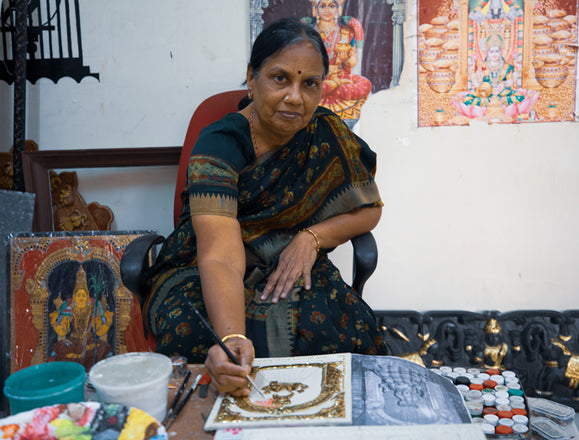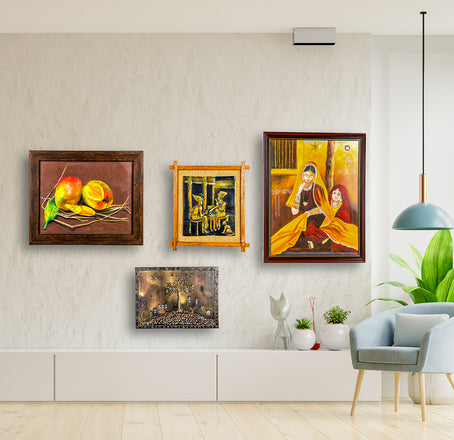
About

Vanmathi Balakrishnan
The founder Vanmathi Balakrishnan hails from Kumbakonam town in the Tanjore District. She has been trained in the traditional art form by the native artisans of the Tanjore region for several years.
Best Artist Painting

Latest Paintings Collection
Discover the World Through Original Paintings For Sale
Testimonials

Wonderful balaji tanjore painting that gives divine look to my pooja room.
– Mithra

Bought a beautiful customized painting. Awesome collections and great customer service.
– Mayank Pandey

Had a unforgettable painting at my home that gives luxurious look. Thanks to Mangala Arts and its artists.
– Shaiju

A great experience with Mangala Arts Team.
– Nirmal

Shipping Policy
For Shipping details
Latest Blog
Gifting Tanjore God Paintings: Art and Spirituality Combined
July 18, 2024

Tanjore paintings, also identified as Thanjavur paintings, are well-known for their combination of art and spirituality in a distinct way. Coming from the lively area of Tamil Nadu, these works of art have stood the test of time. They are well-loved and well-appreciated representations of India's diverse cultural legacy. Gifting a Tanjore God painting means giving not just art, but it is a way of bestowing a blessing of divine grace. Let's investigate the reasons behind why these paintings are unique and why they are ideal as presents. Table of Contents Importance of Giving Art Brief Introduction to Tanjore Paintings Artistic Elements of Tanjore Paintings Spiritual Significance of Tanjore God Paintings Why Tanjore God Paintings Make Perfect Gifts Choosing the Right Tanjore Painting Conclusion Importance of Giving Art When you give artwork as a gift, it is a considerate and classic act. It goes beyond the usual, providing something that resonates with the spirit. Art brings out feelings, triggers reminiscences and special times, and, above all, endures through history. The present significantly influences the recipients, serving as a reminder of their cultural heritage and religious faith. Brief Introduction to Thanjavur Paintings Tanjore artworks are famous for their unique design and detailed decorations. Frequently, they portray Hindu deities, emanating a feeling of holiness and loyalty. These artworks are more than just paintings; they are a demonstration of faith for the artists. Every stroke symbolizes the artist's deep respect for the divine, and they are created with great attention to detail. Tanjore paintings feature vibrant colors and golden foil accents, and these features set them apart as works of art. The Spiritual and Artistic Importance of Tanjore God Paintings Thanjavur paintings have the ability to captivate visually while also inspiring spiritually. Every artwork combines artistic skill and devotion in perfect harmony. The artists use gold foil to bring about a heavenly shine, representing both purity and divinity. The bright hues and detailed designs perfectly symbolize the gods, elevating these artworks as ideal for any personal shrine or holy area. Importance in Society and Traditions of Tanjore God Paintings One can trace the origins of Tanjore paintings to as remote as the 16th century in South India, during the Nayak and Maratha eras. Artists created paintings that decorated temples and palaces with the support of royal patrons. Throughout the years, people have upheld these customs and handed them down through generations, keeping their importance in both culture and religion. Every Tanjore painting narrates a tale of dedication, artistry, and traditional legacy, turning it into a valuable inheritance. Artistic Elements of Tanjore Paintings People recognize Tanjore paintings for their opulent and radiant characteristics. Artists include gold foil in their paintings, providing a luminous shine that reflects light in a stunning way. These paintings also use a lively color scheme, with shades of red, green, and blue taking center stage on the canvas. When elaborate features, like jewelry and decorative patterns, need to be added, artists carefully paint them by hand, stroke after stroke, demonstrating the artist's expertise. 1. In-depth Explanation of the Artistic Approach Crafting a Tanjore painting is a complex task that demands great expertise. The process starts by preparing a wooden surface, which artisans then cover with a combination of chalk and glue. The artist outlines the deity and then fills it with vibrant colors. They place gold foil carefully on surfaces such as jewelry and clothing, providing the painting with its distinctive shine. Artists add intricate details at the end and breathe life into the painting. 2. Utilization of Gold Foil, Bold Colors, and Complex Designs The gold foil in Tanjore paintings represents both divinity and wealth, not just decoration. The artist carefully chooses vibrant colors to represent the different qualities of the deities, with intricate details showcasing their skill and attention to detail. This mixture of components creates a painting that is visually impressive and deeply meaningful. 3. Themes and subjects that are popular in Tanjore God Paintings Thanjavur paintings mainly feature Hindu deities. The most popular deities include Lord Krishna, Lord Ganesha, and Goddess Lakshmi. Artists depict the Gods in symbolic stances, encompassed by intricate settings featuring plants, animals, and buildings. These paintings are very dear to the people who buy them due to their recurring themes of devotion, prosperity, and protection. Spiritual Significance of Tanjore God Paintings 1. Portrayal of Gods and Sacred Symbols People respect Tanjore paintings highly for they depict gods and goddesses in their full splendor. Every painting is like a visual form of prayer, seizing the core of the divine. The serene expressions and detailed adornments of the deities evoke feelings of peace and reverence. These paintings act as a central focus for worship and meditation, aiding followers in forming a connection with the divine. 2. Symbolism of Spirituality in Tanjore Paintings Each aspect of a Thanjavur painting carries a spiritual meaning. The gold foil symbolizes purity and divinity, and the vibrant colors represent the different attributes of the deities. Blue commonly represents Krishna's infinite nature, while red signifies Lakshmi's prosperity. The intricate decorations symbolize the wealth and plenty that the gods grant to their followers. 3. Significance of Tanjore Paintings in Religious Ceremonies and Interior Design Tanjore paintings are essential for religious ceremonies and decorating homes. You will find them in prayer rooms, acting as a central focus for daily worship. People believe that their presence brings blessings and protection to the household. Furthermore, these artworks elevate the visual attractiveness of a residence, bringing in a sense of cultural sophistication and spiritual calmness. Why Tanjore God Paintings Make Perfect Gifts 1. Heritage of Culture and Enduring Charm When you present a Tanjore painting, it is like presenting a cultural legacy. These paintings possess an enduring charm that goes beyond the influence of current fads. They showcase India's abundant artistic heritage and profound spirituality. A Tanjore painting is a present that will be valued for years, acting as a permanent memory of one's cultural heritage. 2. Meaning of Wealth, Safety, and Favor Tanjore God paintings, filled with symbolism, are perfect for giving as gifts. People believe that they bring wealth, safety, and good fortune to the recipient. These paintings express sincere wishes and divine blessings, whether for a wedding, housewarming, or festival. They represent more than just art; they symbolize good intentions and spiritual favor. 3. Special and Considerate Present for Different Events In a world where most gifts are ordinary, a Tanjore painting shines as a special and considerate gift option. It's a present that connects deeply on a personal and spiritual level. Whether you're giving it for a special event or just to express gratitude, a Tanjore painting is guaranteed to make a long-lasting impact. Choosing the Right Tanjore Painting 1. Guide for Choosing a Genuine Tanjore Artwork Authenticity is crucial when selecting a Tanjore painting. Search for artwork that incorporates genuine gold leaf and organic hues. Examine the intricate craftsmanship and attention to detail in authentic Tanjore paintings. We recommend purchasing from trusted sources to make sure you receive an authentic item. 2. Comprehending the Excellence and Skillfulness The materials used and the skill of the artists are what determine the quality of a Tanjore painting. Top-notch paintings utilize high-grade timber, organic pigments, and genuine gold leaf. The workmanship must be flawless, with seamless surfaces and no apparent imperfections. A skillfully created Tanjore painting is a genuine masterpiece. 3. The Importance of Gods and Goddesses Various gods hold varying importance in Tanjore artworks. Lord Krishna is commonly portrayed engaging in playful divine activities, representing happiness and affection. Lord Ganesha, known for removing obstacles, bestows wisdom and prosperity. Goddess Lakshmi represents riches and plenty. Select a god or goddess that aligns with the beliefs and goals of the individual. Conclusion Presenting Tanjore God paintings combines the elements of art and spirituality in a unique manner that is unmatched by many other gifts. These artworks honor India's rich artistic tradition and profound spiritual essence. They add charm, good fortune, and a feeling of sacredness to any area. If you want to find a heartfelt present for a special event, Tanjore paintings are a great option. Besides, they also are classic masterpieces to decorate your home with. Their lasting appeal and importance ensure that people will value and appreciate them for many years to come. If you are interested in buying Tanjore paintings online, check out the collection at Mangala Tanjore Paintings. Explore genuine Tanjore paintings that reflect the true beauty and skill of artistry. Enhance your environment and enhance your life with the everlasting charm of Tanjore art.
Tanjore Paintings as Investments: Value and Preservation Tips
July 15, 2024

Tanjore paintings, or Thanjavur art, are a fascinating tradition of South India that has lived to tell its tale. These lovely pieces have their origin in Tanjore (presently known as Thanjavur) in Tamil Nadu, a city located in the south of India. What keeps them distinct from other traditional forms of art are their intricate details, vibrant colors, and deep cultural roots. Such is the allure of Tanjore paintings that they still captivate art enthusiasts and collectors worldwide. They appreciate these paintings for their everlasting beauty and cultural importance. The passion of the craftsmen who put their hearts into every stroke of the brush is not lost on them. Table of Contents What Are the Reasons to Put Money into Tanjore Artworks? Where Can I Obtain Tanjore Artwork? How Should I Preserve My Tanjore Paintings? Conclusion What Are the Reasons to Put Money into Tanjore Artworks? Purchasing authentic Tanjore paintings online can be thought of as a wise investment as there is the possibility of significant profits. While these cultural heritage artworks are visually striking, what is lesser known is that they also appreciate in value. Tanjore paintings are in high demand among collectors and enthusiasts from around the world. This is because they involve meticulous craftsmanship and the use of gold and gemstones which are valuable materials. Their intricate focus on small details and the use of ancient methods and costly raw materials elevate them to become valuable masterpieces that increase their value with time. Indeed, possessing an authentic Tanjore painting is more than just decorating your walls with stunning Tanjore paintings. It's also about investing in a historical item that will increase in value over the years. The online Tanjore paintings highlight the talent and craftsmanship of their artists, as well as the cultural heritage of the Tanjore area. Besides, though the themes running through them may be the same, they are generally one-of-a-kind fascinating pieces. The return on your investment will also grow, making it a smart choice for individuals seeking to broaden their collections. Where Can I Obtain Tanjore Artwork? Due to the rising trend of shopping on the internet, buying exquisite Tanjore paintings online has become easier than ever before. If you are looking for the best place to buy Tanjore paintings, a number of trustworthy websites stand out as primary options. MeMeraki.com is a top online platform for purchasing Tanjore art. In this place, you can discover a diverse selection of Tanjore paintings online produced by skillful artisans using traditional techniques. On this site, there is a wide selection of sizes, designs, and price points available. This simplifies finding the perfect item that aligns with your tastes and budget. CholaImpressions.com is another great option that focuses on top-notch Tanjore paintings. At CholaImpressions.com, you will find beautiful Tanjore Paintings online, created on canvas with detailed relief work and skillfully incorporated glass beads. Every piece includes 22-carat gold foil that artisans carefully place on areas to be highlighted, along with an authenticity certificate for the gold foil used in the Tanjore Paintings. MangalaTanjorePaintings.com is another reliable place for genuine online Tanjore paintings, providing a customized shopping experience for lovers of art. This website displays a wide variety of exquisite Tanjore paintings, all skillfully made by talented artisans. The artists focus on making art the traditional way with vivid colors and detailed designs, including 22-carat gold foil for a majestic finish. No matter which website you select, buying Tanjore paintings online is the most convenient way to bring the beauty of this art form into your home or workplace. Through some thorough exploration, you can discover authentic and beautiful Tanjore paintings to bring a touch of sophistication and cultural depth to your area. How Should I Preserve My Tanjore Paintings? Due to increasing Thanjavur painting prices over time, Tanjore paintings are exquisite masterpieces that require careful maintenance and attention. Below are key pointers to guarantee your Tanjore artwork continues to be a striking focal point for future generations. Correct framing is crucial to maintaining the fine details and vivid colors of your Tanjore art. Choose a frame that complements the intricate design of the painting and utilize high-quality materials to safeguard it from UV rays and environmental elements. When presenting your Tanjore artwork, pick a spot that is not exposed to natural elements like sun, dampness, or changing temperatures. Indirect lighting will display the radiant gold leaf accents of the piece without causing any fading or warping in the long run. Do not try to clean or repair the painting on your own - trust experienced professionals for this delicate job. Frequently wipe the frame and glass with a gentle, dry cloth to keep it looking clean and new. By adhering to these expert recommendations, you can display your Tanjore painting as the enduring masterpiece that it truly is. May its beauty enchant viewers for many years ahead. Conclusion Browsing original Tanjore artworks on the internet provides a special chance to admire their enduring charm and make a worthwhile purchase. Learning the reasons for investing in Tanjore paintings, finding where to get them, and learning how to maintain them will boost your admiration and guarantee their durability. Appreciate the valuable history and creative expertise of these beautiful items, adding a cultural sophistication to your collection. If you want to browse Tanjore paintings on the internet, check out MangalaTanjorePaintings. In our assortment, you will discover a variety of themes, sizes, and price ranges, guaranteeing you will discover the ideal piece to enhance your decor.










